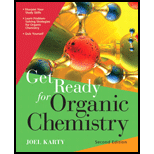
Interpretation:
The potential leaving group in the reactant and in the product of the given proton transfer step are to be circled, and the actual form in which it leaves is to be written. The leaving group is to be labeled as a good or a poor leaving group.
Concept introduction:
A leaving group is the atom or group of atoms that breaks off from the substrate during a substitution or elimination reaction. The leaving group is also a nucleophile and departs with its electron pair from its bond with the carbon atom. A good leaving group must be stable; in solution one, it has departed. This can be determined from its strength as a base. A weak base is a better leaving group than a strong base because it is more stable. This also means that a neutral leaving group is generally more stable than a similar negatively charged leaving group.
Want to see the full answer?
Check out a sample textbook solution
Chapter 9 Solutions
Get Ready for Organic Chemistry
- The following molecule undergoes an intramolecular reaction in the presence of pyrrolidinium acetate, the protonated form of pyrrolidine. Draw the product of this reaction, assuming that a dehydration reaction takes place.arrow_forwardLet's say we had an acid-base reaction of acetic acid and hydronium. What would the products be? Where would the positive charge be for the acetic acid's conjugate acid? Why would the hydrogen add to the oxygen that is double bonded instead of the oxygen that is single bonded (on acetic acid)?arrow_forwardModify the given structure and the product formed.arrow_forward
- Given the general reaction coordinate diagram for an El reaction, what does the 1st transition state refer to? TS E TS, SM Reaction Coordinate An activated complex between the leaving group and carbocationic species. An activated complex between the nucleophile and carbocationic species. None of these O An activated complex between the base and carbocationic species.arrow_forwardHow will I determine if a neutral compound is an eletrophile or a nucleophilearrow_forwardDetermine which would be more reactive with a nucleophilearrow_forward
- For each of the following reactions, fill in all the boxes with the indicated structures. For the intermediate box, draw a structure that helps you understand/determine the product.arrow_forwardPlease draw a detailed mechanism for all steps in the following reaction sequence. Please clearly show electron movement.arrow_forward1. Copy and complete the following table by indicating whether each of the following scenarios would either INCREASE or DECREASE the rate of reaction. Scenario Putting reaction vessel in the fridge Decreasing temperature Removing source of heat energyN Lowering temperature Putting reaction mixture in a hot oven Rate of Reactionarrow_forward
- Give detailed Solution with explanation neededarrow_forwardI. Of the following reactions, answer what is requested:a) Analyze the type of alkyl halide and determine if the nucleophile is strong or weak and also if it has a basic character.b) According to the previous paragraph, determine if there is competition between the substitution and elimination reactions.c) Describe the mechanism of each of the product (s) that are formedd) Of the product (s) that are formed, indicate which one comes from the substitution reaction and which one from eliminatione) If two or more products are formed, indicate which would be the majority and explain why.arrow_forwardThis reaction is an example of conjugate addition of a nucleophile to an a,ẞ-unsaturated carbonyl. H3C LOCH3 H₂O H3C OCH3 OCH3 Draw the two resonance structures of the enolate anion intermediate for this reaction. • Draw an R1 group in place of CoA. The R group tool is located in the charges and lone pairs drop-down menu. • Draw one structure per sketcher. Add additional sketchers using the drop-down menu in the bottom right corner. Separate resonance structures using the symbol from the drop-down menu. • O H CH3 ? [Farrow_forward
 Organic Chemistry: A Guided InquiryChemistryISBN:9780618974122Author:Andrei StraumanisPublisher:Cengage Learning
Organic Chemistry: A Guided InquiryChemistryISBN:9780618974122Author:Andrei StraumanisPublisher:Cengage Learning Organic ChemistryChemistryISBN:9781305580350Author:William H. Brown, Brent L. Iverson, Eric Anslyn, Christopher S. FootePublisher:Cengage Learning
Organic ChemistryChemistryISBN:9781305580350Author:William H. Brown, Brent L. Iverson, Eric Anslyn, Christopher S. FootePublisher:Cengage Learning

